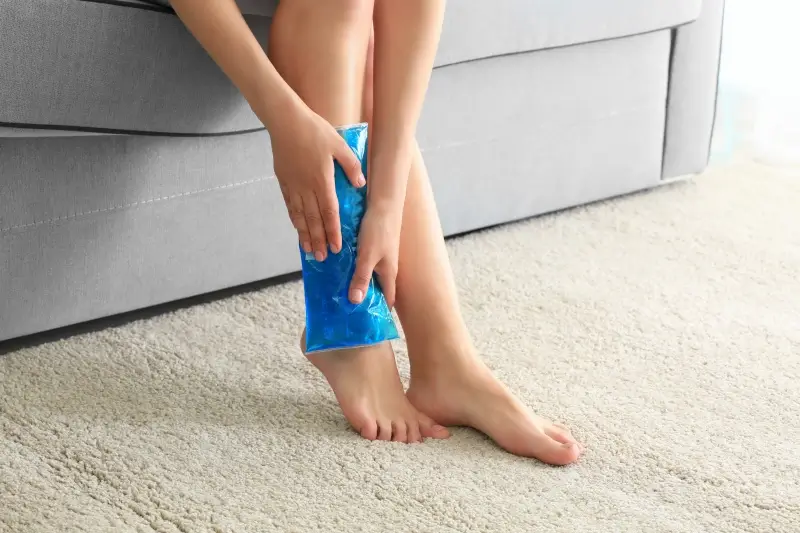Leg muscle cramps and, for example, eyelid twitching are quite common ailments that affect almost everyone from time to time. Of course, some people are more susceptible to these unpleasant symptoms, while others experience them very rarely or even episodically. However, everyone wants to avoid cramps in the future. What are muscle cramps, what is their cause, how to relieve them and prevent their recurrence?
In the text below, we will try to answer these questions and suggest easy-to-implement lifestyle changes that will allow you to forget about night cramps and go to sleep without worries.
Muscle cramps – what are they?
Muscle cramps are often trivialized. They may seem trivial, after a few minutes, sometimes even faster, the cramp subsides. Unfortunately, cramps, especially if they occur at night, can have a very large, negative impact on the quality of life. The discomfort during a cramp is significant – severe pain can paralyze you for several minutes and make you have to break away from everyday activities.
If you suffer from cramps at night, the discomfort is doubled – not only do you feel pain during and immediately after muscle cramps (pain in the area of, for example, the gastrocnemius muscle can last for several days), but above all, the cramps disturb your sleep. Sudden waking up and fear of another attack effectively reduce the quality of night rest, which after a few weeks can cause a feeling of fatigue, problems with concentration or disturbance of psychological functions.
Muscle cramps most often occur at night, during relaxation, but they can affect you during exertion, a long journey or daily duties.

Fig. 1. A cramp can prevent you from doing sports and performing everyday duties.
What are the causes of muscle cramps?
If you are concerned about the problem of painful muscle cramps, you are certainly wondering what they are caused by. Indeed, a thorough understanding of the cause of this state of affairs can help you completely eliminate it and return to balance.
Your lifestyle has a very large impact on the occurrence of cramps. Below we have summarized the most important factors, check which of them apply to you:
A sedentary lifestyle, little exercise and low sports activity
A sedentary lifestyle and office work contribute to maintaining an incorrect body posture. Especially if you work in the recently popular home-office system (remotely from home), the temptation to sit in a seemingly comfortable armchair, lie on the couch, or sit on a kitchen chair with your legs on your legs is great.
An incorrect sitting position causes pressure on the blood vessels located in the legs. As a result, there is a decrease in blood supply to the muscles and surrounding tissues of the lower limbs. Lack of dynamic circulation quickly leads to muscle oxygen deficiency, which may be one of the causes of cramps.
Take regular breaks while working. If you have trouble remembering to take them, set a timer that will remind you with a bell that it is time to rest and stretch your legs. Currently, wearable solutions are very popular, i.e. wristbands, watches and mobile applications that constantly monitor, for example, the level of physical activity and count down the time since the last movement. A wristband or watch will remind you every few minutes to get up.
You can do some of your work standing up, even if you do office work every day. Did you know that you can use a desk that is adjustable and can be set to work in a standing position? It turns out that for many people, it is more comfortable than sitting for many hours.
If your workstation is not properly organized, consider implementing changes. It may be difficult for you to assess what modifications you need on your own – you may only need to adjust the chair or the height of the countertop. A desk set too low can press on the upper part of the thighs, which also contributes to the lack of oxygen in the leg muscles. If you have the opportunity, consult a specialist – an ergonomician will advise you on what changes to make, and you will feel relief immediately.

Fig. 2. A sedentary lifestyle promotes leg cramps.
Sometimes you can work not only sitting or standing at a desk but also, for example, rocking on a Pilates ball. A large ball allows you to sit comfortably and forces your body to constantly tense your abdominal and back muscles. This strengthens them and relieves the load on your legs, which are not supported by the entire body weight.
If you lead a sedentary lifestyle and none of the changes mentioned above are possible to implement in your case (e.g. you work in a small office, at the reception or in a place where it is not possible to modify your workstation), take care of what happens after it.
Exercise regularly and make sure you are active every day. Even if you have little time, you can protect yourself from cramps by taking care of sports:
- try to get off a little earlier when going to work or coming home, a short walk will do your muscles good;
- choose the stairs instead of the elevator;
- try to shop in places where you can also take a walk, local markets and bazaars are a great source of good quality vegetables and fruit;
- if you don’t feel like doing any sports, choose walking, marching, Nordic walking.
Fatigue, lack of proper hygiene at work
Leg cramps can occur in people who are overtired and overuse their legs. It is usually believed that this problem concerns, for example, people who work standing (customer advisors, salespeople, hostesses, etc.) in reality, leg fatigue can also occur in other cases:
- in people who do sports professionally or semi-professionally, who have overdone the amount of training and did not allow their muscles to regenerate properly, cramps can also occur if the training was too strenuous or the warm-up was omitted;
- in women who wear high heels, where the shoe is not properly balanced and the heel itself is too high (over 6 cm);
- in overweight and obese people whose legs are subjected to hard work as a result of many hours of “carrying” excessive body weight.

Fig. 3. Cross-legged position and prolonged wearing of high-heeled shoes can cause muscle cramps.
Incorrect level of body hydration
Water is an environment in which many processes necessary for the proper functioning of the body take place. Even a small loss of water (approx. 2%) is associated with the possibility of symptoms of improper body hydration. An adult, healthy person should provide about 1.5 – 2 liters of water per day with food and drinks. Hot weather, strenuous exercise, stress, mental effort and excessive sweating contribute to water loss.
It is very important to drink the right amount of water. Strong tea and coffee are not able to meet the needs of the body and do not hydrate it. If you experience cramps, take a look at the amount of fluids you drink. Choose good quality, mineral water. If you do not like its taste, consider using an electrolyte preparation, preferably in the convenient form of water-soluble, effervescent tablets. By choosing a vitamin preparation, you provide not only the necessary electrolytes but also take care of the correct level of vitamins, some preparations provide even 100% of the daily requirement for vitamin C, niacin, vitamins from group B or E.
Abuse of alcohol and caffeinated beverages
Alcohol increases the excretion of fluids and electrolytes in the urine due to the inhibition of vasopressin. As a consequence, this leads to a decrease in the level of hydration. Reduce alcohol consumption gradually until it is completely eliminated from the diet.

Fig. 4. Drinking alcohol can help flush electrolytes from your body.
Coffee, strong tea and energy drinks contain significant amounts of stimulating caffeine. Like alcohol, it can contribute to disorders of the nervous and muscular systems. Do not look for stimulation in energy drinks, especially if you care about your figure (due to their calorific value and added sugar content) and a healthy diet. If you feel tired, fatigued, or have a drop in energy, consider using hydrating products that additionally contain vitamins and ingredients that have a positive effect on the nervous system and psychological functions. Drinks of this type are a great idea for refreshment, they have a fruity taste and an interesting form of effervescent tablets, and will appeal to people who do not like the taste of water.
You can enhance the effect of a vitamin preparation by doing breathing exercises and so-called active breaks at work, during which you will stretch and oxygenate. Before doing them, open the window, relax and focus for a few minutes only on your breathing and the technique of the movements performed.
Rescue during a cramp
A cramp can be very unpleasant, it wakes you up at night, interrupting your sleep, or surprises you during the day, which is an obstacle to completing private and professional tasks. People who experience cramps often develop a fear over time that straightening, bending the leg, stretching, etc. will cause a series of cramps that will be difficult to cope with.
The best way to prevent cramps is to eat a balanced diet, move around, and maintain a sufficiently high level of fluids and electrolytes. However, if, despite the changes you have implemented, you still experience cramps, learn to soothe them and reduce the duration of a single attack.
During a cramp, try to relax the limb as quickly as possible and straighten it. Getting up from a chair or bed, straightening your leg on a pillow, or supporting it with your hand can cause the muscle to relax and the cramp to end faster.
After a cramp, try to massage the muscle. Pressing movements will alleviate the discomfort and make you feel relief faster. Cold compresses can also be helpful. If you experience cramps particularly often, be prepared and make sure you have a cold compress in the fridge.

Fig. 5. Cold compress is a relief during cramps.
Prevent cramps with a diet
A properly nourished organism that does not lack essential nutrients, vitamins and minerals is unlikely to react with cramps. Treat this as a prescription and take a look at your diet. Check if:
- you eat at least 5 portions of vegetables a day – they should be part of every meal you prepare. A portion is a handful of small vegetables or salads, a single tomato, a few small carrots or radishes;
- you take care of your supply of vitamins and antioxidants by choosing healthy, ripe fruit – fruit should be part of two out of five daily meals. They are great as a dessert or an addition to breakfast, for example. Choose only plump ones, without discoloration or traces of mold on the skin;
- you eat full-value protein – regardless of whether you are on a vegan/vegetarian or traditional diet, you need to control the amount of protein you consume. The healthiest way to get them is through lean meats and fish (turkey, chicken, rabbit, lean beef, cod, oily sea fish). Additionally, meat contains selenium, which is one of the elements necessary for the proper functioning of the nervous system. Part of the protein supply should come from plant sources – soy, tofu, legumes and nuts are excellent sources.
Vitamins and minerals in the fight against cramps
What vitamins and minerals should you pay special attention to when fighting muscle cramps? Which ones should you look for in your diet and how to compose it to ensure their proper supply? Below you will find a summary in which we have described the ingredients that cannot be missing from your diet and which affect the nervous system and the proper functioning of muscles.
| Ingredient | Action |
| Potassium |
|
| Magnesium |
|
| Iron |
|
| Zinc |
|
| Vitamin B6 |
|
| Vitamin B12 |
|
| Chrome |
|
As you can see, there are many minerals and vitamins that are related to the occurrence of the feeling of muscle cramps. Look for them primarily in fresh, good quality vegetables and fruits. Vitamins from group B (B6, B12) can be found mainly in dairy products and meat, iron has similar sources, additionally plant sources of iron can be cocoa, pistachios or sesame. Chromium can be found in broccoli, wheat germ, some types of herbs and in meat, e.g. in poultry liver.

Fig. 6. Pistachios are a good source of B vitamins.
If you want to make sure that your diet does not lack zinc, make sure that you eat onions, garlic, pumpkin seeds, meat and dairy products, bran, eggs or, for example, oysters, which are admittedly an unusual product for Poles, but added from time to time to the daily menu can be an interesting supplement to the diet.
In the period of increased demand for all the above-mentioned ingredients, try to include a vitamin preparation in your diet. Of course, nothing can replace a properly balanced diet and hydration, but you can feel better temporarily. The Plusssz 100% Skurcz Complex dietary supplement is a proposal for a ready-made vitamin preparation that provides a supply of vitamins and minerals.
The content of potassium and magnesium in the composition is a benefit for people who, among others, struggle with persistent muscle cramps because these minerals contribute to the proper functioning of muscles. In addition, Plusssz 100% Skurcz Complex contains 5 B vitamins in amounts that provide 100% of the daily requirement for adults.

Fig. 7. A ready-made vitamin preparation enriched with potassium is a good choice for people affected by muscle cramps.
Questions and answers to the most common questions about cramps
I often have cramps at night, I read that athletes deal with them by pressing hard on the muscle with a sharp tool, does this method really work?
We warn against such solutions. They can lead to damage to the skin and muscle tissue, scarring and permanent marks on the skin. Instead, during cramps, make sure to immediately try to relax the muscle tissue and, for example, stretch your leg. A gentle massage with circular movements and a cool compress (e.g. from a wet towel or a so-called cold pack available in the pharmacy) will reduce the discomfort associated with the cramp and shorten it.
If cramps recur and are persistent for you, take a look at your habits, diet and fluid intake. Perhaps the level of vitamins and minerals is too low. Consider adding a vitamin supplement to your diet or consult a specialist who will suggest changes to your diet.
Can cramps be prevented?
Of course, yes, preventing them is a much better method than alleviating their symptoms. Reducing stress, allowing yourself to rest, taking care of proper habits regarding activity, the clothes you wear (tight skinny jeans and high-heeled shoes promote calf and foot cramps) will help you avoid cramps.
If you are sure that your body is hydrated, you do not lack vitamins and you take care of good habits, consider consulting a specialist.
How to compose a diet that is full of nutrients?
It may be difficult for someone who is not interested in nutrition. Familiarize yourself with the information we have provided in the earlier parts of the article. Implementing the principles published by the World Health Organization (WHO) in the form of a food pyramid will make it easier for you to control your meals and allow you to predict which products may be missing from your diet.
Regardless of whether you are on a traditional diet containing meat or a vegetarian one, make sure you have an adequate supply of protein, zinc, chromium, magnesium, potassium, sodium and B vitamins (B6, B12) – all of these ingredients can protect you from leg and other muscle cramps.
Summary
Cramps are quite common. They are often trivialized, while they can effectively reduce the quality of life and affect, among other things, the quality of sleep. Relieving their symptoms can be difficult, it is better to prevent them. How? By taking care of proper hydration of the body, exercise and the content of vitamins and minerals in the diet.
Bibliography:
- Kijowski J., Eggs as a valuable source of bioactive ingredients, “FOOD. Science. Technology. Quality” 2013 no. 5, vol. 90, pp. 29-41.
- Cicha M., Magnesium good for everything, “Twój Farmaceuta” 2017, no. 14.
- Roy S., Muscle cramps – a short review of possible causes and available treatment options with particular emphasis on the occurrence of this disorder in diabetes, “Diabetologia Praktyczna” 2019, no. 5, vol. 6, pp. 346-354.
A balanced diet and a healthy lifestyle are important for maintaining health.
